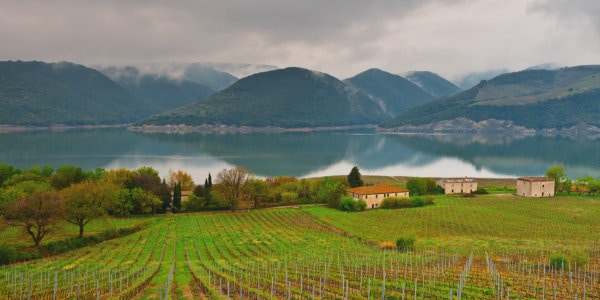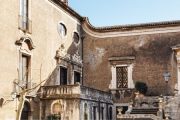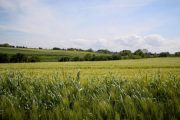After checking in, we drove up into the old town, even though there is a funicular railway that takes pedestrians up, as we wanted to minimize walking by keeping the car close at hand. We found a half-empty parking lot for tourists charging a reasonable 4.50 euros for three hours, left the Jeep there, and walked along narrow winding medieval cobbled streets past innumerable pasticcerias, trattorias, souvenir shops and the like, all with surprisingly few customers. It appeared to be the last day of school, and high-spirited teenagers were spraying one another with water pistols in the 32-degree heat in the Piazza del Duomo where we sat eating an improvised lunch of apples and peanuts, in awe of the beautiful cathedral in front of us, with its façade of mosaics, stained glass and assorted sculptures, but its interior was quite overwhelming, especially as on that day the church was not full of chattering tourists, but more properly a place for prayer and contemplation for a handful of elderly worshippers.
A guide book to the frescoes and paintings that illuminate so much of the duomo is today necessary to explain Latin inscriptions and Biblical allusions and allegorical representations once but no longer assumed to be common knowledge as it had been in the medieval period, but Gentile da Fabriano’s recently-restored portrait of Madonna Enthroned with the Child and Angels (1425) is not one of these, while the frescoes covering the walls and ceiling of the Chapel of the Madonna di San Brizio, painted by Luca Signorelli (1450-1523) are. Here are depicted the Apocalypse, Bodily Resurrection, the Elect in Heaven and the Damned in Hell at the End of the World, not as C.S. Lewis imagines it in his The Last Battle, but with compelling, vigorous pictures of the Antichrist trying to lead the faithful astray in one fresco, visions of earthquakes and falling stars, omens of a fearful future, and, in another, skeletons of the faithful dead arising from their graves to be re-clothed with new bodies once resurrected.
From the Duomo we walked to the belvedere at the north end of old Orvieto, where we marvelled at a spectacular view of the countryside below, with the busy autostrada in the distance. Up here, sitting on a bench in the leafy but deserted children’s playground of Piazzale Carducci abutting the lookout, it was blessedly quiet and peaceful above the rush and tumult below. At the car park, we walked in the Fortezza Albornoz, or what remains of it. Its gateway is the entrance to public gardens, enclosed by walls of tufo a mere four feet high on the very edge of cliffs with a vertiginous drop of several hundred feet. There is a mention of ruins of an Etruscan temple nearby, but we could not find it. There is a cavalier disregard of the past in several of these hill towns: few explanatory signs appear, and even an ill-maintained war memorial there lists only the illegible names of the dead. It was still 32 degrees Celsius when we returned to the Villa, so we went in for our postponed swim: it was definitely acquafredda, most welcome under the circumstances. As I made a lengthy entry in my diary on the deck of the pool, I had a view of the new town, busily getting and spending below, with frequent fast trains arriving and departing in silent accompaniment. Then it was time to go for a walk in search of supper. We found a pleasant trattoria nearby which served us each bowls of home-made minestrone thick with vegetables, pasta, and potatoes, followed by a mixed grill and salad for Louise and veal scaloppine for me. With a beer each, tax, and tip, it was ours for 40 euros, and well worth it. Some day, Deo volente, I hope to re-visit Orvieto…
After an excellent breakfast the next morning by the pool, we left for Rome, leaving Umbria behind. What happened there, however, is material for another time.

Lake Corbara in Italy




